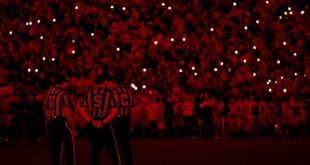When Mauricio Pochettino stands on the touchline at SoFi Stadium in Los Angeles on June 12, 2026, watching his US men’s national team (USMNT) begin their World Cup finals campaign, the eyes of the rest of the world will be on him. Nothing he has experienced in his career as a coach at club level will compare to becoming one of the main characters in the greatest show on earth.
There are some elite managers who change their team of assistants from job to job. Pochettino is not one of them. Joining him with the USMNT are four people he knows very well; Miguel ‘Miki’ D’Agostino, Antonio ‘Toni’ Jimenez, Jesus Perez, and his son Sebastiano Pochettino.
He first assembled the core of his team — Perez, Jimenez and D’Agostino — in his first role at Barcelona-based Spanish club Espanyol, where he became the manager in 2009 at the age of 36, a couple of years after ending his playing career with them. Sebastiano joined them as a fitness coach and sports scientist at Tottenham Hotspur, Paris Saint-Germain and most recently Chelsea.
There will be one new face too, Silvia Tuya Vinas, who speaks English, Catalan and Spanish and joins as a strength and conditioning coach.
Pochettino will tap into the expertise of those already in the U.S. Soccer set-up, and is open to the possibility of adding a coach who is more familiar with American soccer and this group of USMNT players.
Speaking at his first USMNT press conference in New York earlier this month, he said: “I think we have very qualified people working in the federation that can very quickly help us. But of course, we are flexible and we are always open to adding people because we know that football is changing; technology is here and now we need hands to work, people to work, because we need to analyze (lots of things).
“We have tools to work really, really hard. In the past, many years ago, you had only one coach, one fitness coach, one analyst and that’s it. But now in this business it’s really important to have all that you need to cover (everything), and you need qualified people working next to us to provide us information to be better and to help the players to perform.”
It is impossible to understand Pochettino’s work and his journey to date without understanding the coaching staff who have followed him every step of the way so far, from Spain to England, to France, back to the UK and now across the Atlantic.
Here, The Athletic profiles the coaches who will help prepare the USMNT for the 2026 World Cup on home soil — and how they operate as a team…
First, there is Miguel ‘Miki’ D’Agostino, who played with Pochettino for Newell’s Old Boys, a club in their native Argentina (named after an Englishman who was among the pioneers to first bring soccer to that South American country), in the early 1990s.
The two men have been close since they were teenagers playing for Newell’s under now world-famous coach Marcelo Bielsa, marvelling at the routines Bielsa had them going through to get them in tip-top shape. Pochettino loves telling the story of how he used to give D’Agostino a lift to training in his battered old Fiat Uno, only for D’Agostino to accidentally break off one of its doors, something for which he has never paid Pochettino back.

GO DEEPER
This USMNT isn’t a ‘golden generation’ – the data shows it lacks top-end talent
D’Agostino did not have as stellar a playing career as his friend, who won 20 caps for Argentina and played for them in the 2002 World Cup, but when Pochettino took over at Espanyol, he quickly called him in to work on his backroom team, filming sessions from a hastily-constructed tower at the training ground. Even now, he oversees analysis and scouting for Pochettino — hugely important work for a staff who want all possible information at their fingertips. Also, because D’Agostino spent six years playing and coaching in France in the early to mid-2000s, he would interpret for Pochettino in press conferences when they were together more recently at Paris Saint-Germain.
Then there is Antonio ‘Toni’ Jimenez, who played in goal for Espanyol in the 1990s and 2000s. He had a great playing career, including being part of the Spain team that won gold in the football tournament at the 1992 Olympics in Barcelona, alongside future global stars Pep Guardiola and Luis Enrique. He, naturally enough, became Pochettino’s goalkeeping coach at Espanyol and has been part of the backroom team ever since.

Pochettino and Jimenez celebrate Spurs’ Champions League semi-final win over Ajax in 2019 (Bradley Collyer/Getty Images)
Jesus Perez is Pochettino’s assistant manager and his right-hand man. Perez was a fitness coach with a background in sports science who worked for various clubs across Spain in the 2000s. He initially joined Pochettino’s Espanyol as an analyst, in part because he knew how to use the software Sportscode, while also working with the youth academy. Three months later, he became part of the first-team coaching staff.
Perez is Pochettino’s closest confidante, so much so that the new USMNT boss has described him as an “extension of himself”. It was Perez, along with Pochettino’s wife, Karina, who convinced him to move to the Premier League as Southampton manager in early 2013 — one of the most important moments of his whole career — two months after leaving Espanyol by mutual consent.
Pochettino’s work is unimaginable without Perez by his side. He oversees so much of what Pochettino does, from the training loads of players to the monitoring regime to assess their injury risk. He is Pochettino’s eyes and ears, across everything that he needs to know, right down to details like whether players have arrived with a new car or new watch.
The Athletic has every angle covered on Mauricio Pochettino’s appointment as USMNT head coach:
Perez can be tough and is not averse to speaking his mind, but he is also the perfect complement to Pochettino. One of the strengths of their relationship is that they interchange the roles of good and bad cop. If Pochettino is going easier on the players, Perez will take a harder view and vice-versa. In contrast, it was often remarked at Tottenham, who sacked Pochettino and his staff after a poor start to their 2019-20 season, that one of the problems with successor Jose Mourinho and his No 2 Joao Sacramento was that they always echoed one another rather than delivering different messages.
Ultimately, Perez’s energy and ideas make him an indispensable part of the Pochettino team. One former colleague once described him as the most intelligent person he had ever worked with in football, someone who could run every department on the football side of the club better than each one’s actual head.
The final addition was Pochettino’s son, Sebastiano, who earned a university degree in sports and exercise when his father was Southampton manager in 2013 and 2014. He has worked for his dad as a fitness coach and sports scientist at Spurs, PSG and Chelsea and is an established part of the team.

D’Agostino, Pochettino and Perez at Chelsea in 2024 (Darren Walsh/Getty Images)
Silvia Tuya Vinas joins them with the USMNT as a strength and conditioning coach. Vinas, who studied for a PhD in sports science at Barcelona University and speaks English, Catalan and Spanish, most recently worked with the Levante Badalona women’s team in Spain.
The close links between Pochettino’s long-term associates allow them to oversee the holistic approach that has defined Pochettino’s coaching career so far.
At the heart of it — the first aspect of his coaching — is the style of play.
Pochettino teams want to play the positional game, a style of football where you control the space through the positions you take on the pitch. They want to dominate possession, but only as a way to dominate the game rather than an end in itself. His teams always play out from the back and they are especially proud of having done this at two smaller clubs in Espanyol and Southampton rather than only when they inherited elite players. By the end of Pochettino’s one season at Chelsea back in the spring of this year, you could see them playing his football, too.

GO DEEPER
Is becoming USMNT head coach the right move for Mauricio Pochettino?
This is a very structured style of play, more similar to the football of Guardiola than to any other coach, but slightly less rigid than that. The structure of a Pochettino side is integral to being able to press well: you need the players to be in the correct positions if you want to win the ball back within three seconds. You defend the way you attack, as Pochettino’s staff say, rather than the other way around. And so it needs a lot of time on the training ground to get it right.
This brings in the second aspect of the Pochettino approach: building the relationship between the coaches and the squad.
This is often called ‘team-building’, but it will not work if it does not extend beyond the first XI. Pochettino wants to create an environment where every player feels included and respected, famously introducing handshakes every morning at Tottenham. He always makes time to talk to his players as individuals. It is about achieving ‘buy-in’, making sure the players form that shared ethos that is indispensable to any good team. This is in part why Pochettino does not believe in fining players for ill-discipline: he wants them to do the right things because they want to, not because they have to.
If the squad are fully invested, that helps the crucial third aspect of the Pochettino methodology: improving the individual players on the training ground. There are some managers who see their job as just building up to every matchday, tweaking the tactics, motivating the players, but Pochettino and his staff put much more emphasis on constant daily improvement.

Sebastiano Pochettino, centre, has worked under his father as a fitness coach and sports scientist (John Berry/Getty Images)
It is hard work and players do not always relish it at first, but the viewpoint has always been that the ultimate way to respect players is to help to make them better. So there are not many days off and, when the schedule allows, double sessions. There is an emphasis on fitness because there is no point in simply wanting to press if the players do not have the gas in the tank to do it, as well as the understanding of when and how to do so.
Pochettino has a reputation for running his players hard.
At Southampton, he would have the players doing ‘horseshoe’ runs around the pitch, even on a Monday after they had played a match two days before. And during pre-seasons, he loves to give his players the ‘Gacon Test’, invented by Georges Gacon, a French fitness coach who worked at PSG just before Pochettino’s time playing there. The Gacon Test involves 45 seconds of running, then 15 seconds of rest, over and over again, with the distance covered in that running portion increasing steadily each time. It was designed to push players’ maximum aerobic capacity, inspired by Gacon’s work with middle-distance track and field athletes, although in reality these runs are just a small fraction of the overall process and are always done with a specific goal in mind.
There is gym work, too, not traditional weight-lifting but sessions geared towards the functional movements that make up football: running, jumping, kicking or throwing and competing for the ball. Repeating these actions with varying resistance and repetitions builds up the players’ power and endurance over the season. Then there is cognitive training in the gym, asking players to react to lights turning on in a panel in front of them.
The purpose of all of this is fitness and injury prevention and Pochettino players are carefully monitored with saliva tests every morning to assess muscle damage and hormone response. The aim is to know as much about them as possible to establish how they are coping with the rigours of competition.
So many of these methods and techniques are based around the daily life of club football. They rely on constant exposure to the players, to build up their fitness, monitor their physical response and to build that fraternal feeling between a group of players who all suffer together.

GO DEEPER
Pochettino’s tactics: How he can energise the USMNT ahead of the 2026 World Cup
The fascinating thing about Pochettino’s move to international football will be how these ideas and techniques work in that format, where managers can go months during a season without seeing their players. Longer still if there are untimely injuries.
Because Pochettino and his staff will naturally only get their hands on the players for limited amounts of time between now and that 2026 World Cup, which the United States is co-hosting (albeit staging the bulk of the matches, including all games from the quarter-finals onwards) with neighbours Canada and Mexico.
Whatever habits and principles they instil will always be diluted by whatever those players do with their clubs in the intervening periods.
International get-togethers, when they happen, are often more about fine-tuning rather than putting in the hard yards. And yet the success of Pochettino and his staff — and, by extension, the USMNT in a home World Cup — may stand or fall by how much of a positive impact they can make.
(Top photo, from left: Sebastiano Pochettino, Toni Jimenez, Mauricio Pochettino, Jesus Perez and Michel D’Agostino; John Berry/Getty Images)
Source link
 meganwoolsey Home
meganwoolsey Home



